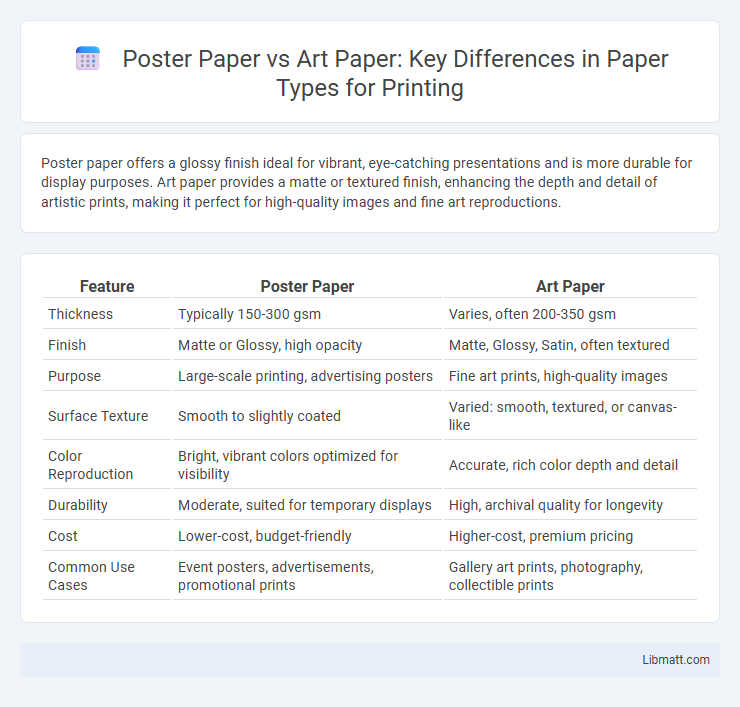Poster paper offers a glossy finish ideal for vibrant, eye-catching presentations and is more durable for display purposes. Art paper provides a matte or textured finish, enhancing the depth and detail of artistic prints, making it perfect for high-quality images and fine art reproductions.
Table of Comparison
| Feature | Poster Paper | Art Paper |
|---|---|---|
| Thickness | Typically 150-300 gsm | Varies, often 200-350 gsm |
| Finish | Matte or Glossy, high opacity | Matte, Glossy, Satin, often textured |
| Purpose | Large-scale printing, advertising posters | Fine art prints, high-quality images |
| Surface Texture | Smooth to slightly coated | Varied: smooth, textured, or canvas-like |
| Color Reproduction | Bright, vibrant colors optimized for visibility | Accurate, rich color depth and detail |
| Durability | Moderate, suited for temporary displays | High, archival quality for longevity |
| Cost | Lower-cost, budget-friendly | Higher-cost, premium pricing |
| Common Use Cases | Event posters, advertisements, promotional prints | Gallery art prints, photography, collectible prints |
Understanding Poster Paper and Art Paper
Poster paper features a smooth, durable surface designed for vibrant color reproduction and large-format printing, making it ideal for presentations and advertisements. Art paper, often textured or coated, enhances detail and depth in fine art prints, emphasizing print quality and material feel. Understanding these differences helps you select the right paper to achieve the desired visual impact for your project.
Key Differences Between Poster Paper and Art Paper
Poster paper is typically thicker, more durable, and designed for large-format printing with vibrant color reproduction, making it ideal for advertisements and presentations. Art paper, often smoother and lighter, emphasizes fine detail and texture, suited for high-quality art prints, illustrations, and photography. The main differences lie in weight, finish, and intended use, where poster paper prioritizes visibility and durability, while art paper focuses on aesthetic detail and texture fidelity.
Surface Texture: Matte vs Glossy
Poster paper typically features a smooth, glossy surface that enhances color vibrancy and sharpness, making images pop with a polished finish. Art paper often comes with a matte texture, providing a non-reflective, subtle surface ideal for fine art prints and detailed illustrations. Choosing between these textures affects how Your artwork is perceived under different lighting conditions and can influence the overall visual impact.
Printing Quality and Color Vibrancy
Poster paper offers excellent printing quality with a smooth surface designed to enhance sharpness and detail, making it ideal for large format prints and vibrant graphic displays. Art paper, typically textured or matte, provides rich color vibrancy and depth, especially for fine art reproductions and photographs, capturing subtle tones and gradients with high fidelity. Both papers optimize color output, but poster paper excels in brightness and gloss, while art paper emphasizes tonal richness and nuanced color transitions.
Paper Thickness and Durability
Poster paper typically features a thickness ranging from 150 to 250 gsm, offering sufficient durability for short-term displays and indoor use. Art paper, often thicker at 250 to 350 gsm or more, provides enhanced sturdiness and resistance to wear, making it ideal for high-quality prints and long-lasting presentations. Your choice depends on the balance between lightweight convenience of poster paper and the robust, premium feel of art paper for durability.
Ideal Uses for Poster Paper
Poster paper is ideal for creating large, eye-catching displays such as presentations, advertisements, and educational charts due to its durability and vibrant color reproduction. It supports high-resolution printing, making it perfect for detailed graphics and bold text that need to grab attention from a distance. Your choice of poster paper ensures that your visuals remain sharp and professional for exhibitions, trade shows, or classroom settings.
Best Applications for Art Paper
Art paper excels in high-quality print projects requiring vivid color reproduction and fine detail, making it ideal for portfolios, fine art prints, and premium brochures. Its smooth texture and superior brightness enhance the appearance of photographs and artworks, providing a professional finish that elevates Your presentations. Unlike poster paper, art paper is better suited for limited-run prints and projects where image clarity and color accuracy are critical.
Cost Comparison: Poster Paper vs Art Paper
Poster paper generally costs less per sheet compared to art paper due to its thinner material and lower production quality, making it a budget-friendly option for large-scale prints. Art paper, often made from higher-quality materials with enhanced texture and durability, commands a higher price reflecting its premium finish and archival properties. For projects prioritizing cost efficiency without sacrificing size, poster paper is the economical choice, while art paper suits refinements in presentation requiring a more luxurious appearance.
Environmental Impact and Sustainability
Poster paper typically has a higher environmental footprint due to its glossy coatings and non-recyclable materials, whereas art paper often uses fewer chemical treatments and can be sourced from sustainably managed forests or recycled fibers, enhancing its eco-friendliness. Choosing art paper can reduce deforestation and minimize waste, supporting sustainability initiatives and lowering carbon emissions in printing processes. Your commitment to environmentally responsible printing is better supported by opting for FSC-certified or recycled art papers that facilitate recycling and reduce landfill contributions.
Choosing the Right Paper for Your Project
Poster paper offers durability and vibrant color reproduction ideal for large, professional displays, while art paper provides a textured finish suited for fine art prints and smaller, detailed projects. Your choice depends on the project's purpose: use poster paper for eye-catching, long-lasting marketing materials and art paper for high-quality gallery prints or intricate designs. Selecting the right paper enhances the visual impact and longevity of your final product.
Poster paper vs art paper Infographic

 libmatt.com
libmatt.com